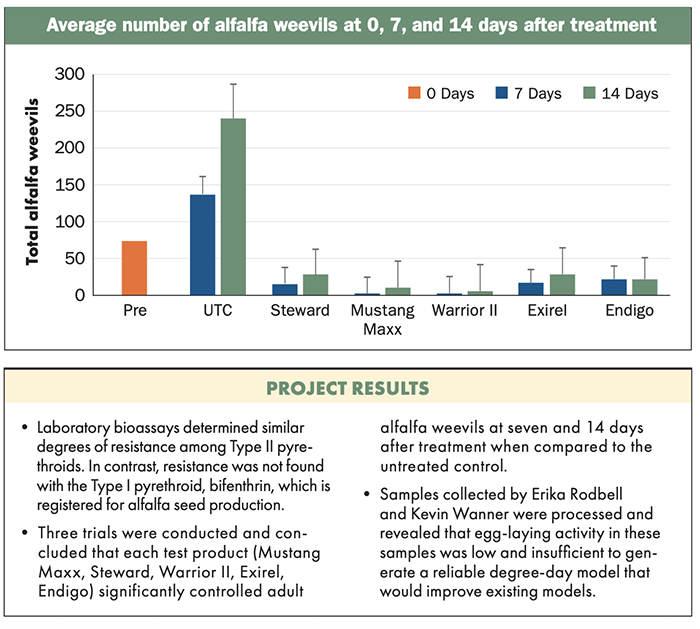
The issue came to light when producers across the state reported reduced first-cutting yields. “A colleague, Kevin Wanner, and I started hearing from producers across Montana that their first-cutting yields were down,” Goosey explained. “When we got into the field, we found adult weevils were active earlier than expected, leading to earlier egg deposition and damage from larvae.”
Historically, most weevil management focused on larvae, but this shift in timing sparked a critical question: Could targeting the adult stage make a difference?
“If the number of egg-laying females is reduced, the number of eggs and subsequent damaging larvae will also be reduced,” Goosey emphasized. “That sparked the questions: How effective are commercially available insecticides against adult weevils, and how long do they persist in the field?”
To find out, Goosey’s team conducted a study at three Montana locations using a randomized block design. They tested insecticides with different modes of action — Steward, Mustang Maxx, Warrior II, Exirel, and Endigo ZC — during the early spring weevil activity period. Before insecticide application, adult and larval numbers were estimated with sweep nets followed by seven- and 14-day post-application estimates to monitor total adult and larval populations and insecticide residue persistence. Each test product significantly controlled alfalfa weevils at seven and 14 days after treatment compared to the untreated control (see figure).
Be proactive
The results carry a strong message for producers: “Early spring alfalfa weevil numbers can be reduced with multiple insecticides, and the timing of insecticide application matters just as much as the product itself,” Goosey stressed. “Some insecticides can lose effectiveness, especially in rainy conditions, so relying on a single early spray without follow-up scouting can lead to underwhelming results.”
Rather than waiting to see larval damage, farmers are encouraged to be proactive. “Our research can help farmers make more informed product selection and timing decisions,” Goosey noted. “We also recommend that producers not wait until they see larval feeding damage. Rather, we recommend scouting for adults and early instar larvae to make the best management decisions for field-level population control.”
Executing such a study across a wide area wasn’t without logistical challenges. “As with all fieldwork, coordinating my team across the large geographic area of southwest Montana while maintaining rigorous sampling protocols is always challenging,” Goosey said. “But that’s the reality of applied field research.”
Looking ahead, the team plans to deepen the study. “I want to expand this work by linking alfalfa weevil adult management to reduced egg numbers, which leads to fewer damaging larvae. At this point, there is no data linkage,” Goosey explained. “In the short term, I already have plans to disseminate this information to alfalfa growers by working with extension agents. In the long term, I hope this research contributes to additional studies that assess threshold levels for adults, which will update and contribute to a more effective integrated pest management framework. Though the study offered no big surprises, it delivered solid confirmation. “I was relieved when the data showed that commercially available insecticides work,” Goosey concluded. “It adds an important tool to the toolbox for alfalfa producers.”
A full copy of the final report can be found at https://alfalfa.org.
This article appeared in the August/September 2025 issue of Hay & Forage Grower on page 12-13.
Not a subscriber? Click to get the print magazine.

